Today, we have a guest blog from Jessica Kane of Federal Steel Supply, Inc., discussing some of the new innovations expected to shape the future of the construction industry.
New angles are being used for the advancement of construction design that will most likely be widespread within the next 50 years. Designers and architects are implementing new trends that could very well be profitable in building spaces for new offices and living establishments. Here are just a few:
One Stop Design
One trend that is already in play is the single design model. A common practice in planning is having an architect create construction documents. They are then handed over to the contractors to be edited and executed. This entire process is now shifting to be done all in one place to save time and money. So, all the outlining, engineering and construction plans are set and submitted to be built directly afterward.
Sustainable and Efficient Solutions
Being energy efficient is a constant concern in construction. So when new buildings are going up, construction around the world has established new ideas on how to conserve. New facades have been used to produce energy through a solar collection and to provide a natural cooling system. For instance, a designer in Melbourne, Australia, has developed a system which includes an outer layer of a side of a building that contains solar panels that shift to collect energy from the sun and provides optimal shading. Another useful technique that has become a sustainable solution in providing energy is the innovation of utilizing the shade of building faces, as seen in Hamburg, Germany. A residential establishment has microalgae installed within glass panels that collects solar energy and creates heat through the process of photosynthesis. The panels can also be shifted in order to provide natural cooling to the building.
Large 3D Printed Structures
 Constructing large structures using a 3D printer has been on the minds of the industry since its initial success in quickly building smaller housing units. Large structures are being composed by 3D printers, but only in part. The MIT Media Lab is finding that results from printing a large building are often rugged and contorted. The product is sanded down and filled with concrete to stabilize the structure. Through these new and innovative projects, engineers are adapting to new technologies for quick and economical production.
Constructing large structures using a 3D printer has been on the minds of the industry since its initial success in quickly building smaller housing units. Large structures are being composed by 3D printers, but only in part. The MIT Media Lab is finding that results from printing a large building are often rugged and contorted. The product is sanded down and filled with concrete to stabilize the structure. Through these new and innovative projects, engineers are adapting to new technologies for quick and economical production.
Drone Assistance
 Building firms are using drones more frequently to help with inspections and material delivery. Drones can provide high accuracy inspections in hard-to-reach areas that can prove dangerous and costly if performed by a human. Drones help in collecting data, executing sophisticated design strategies and accurate data transmission needed by engineers. The construction of complex drones would become crucial in downtime reduction, because it would cause fewer accidents and enhance workflow speed at construction sites.
Building firms are using drones more frequently to help with inspections and material delivery. Drones can provide high accuracy inspections in hard-to-reach areas that can prove dangerous and costly if performed by a human. Drones help in collecting data, executing sophisticated design strategies and accurate data transmission needed by engineers. The construction of complex drones would become crucial in downtime reduction, because it would cause fewer accidents and enhance workflow speed at construction sites.
Adding on with Permanent Modular Construction
Permanent modular construction is the process of constructing buildings offsite (60-90 percent of the building) in a factory-controlled environment which is then moved to its final building site. While this exists now, more of this type of construction will become prominent as it becomes more sustainable and leaves less material waste, less site disturbance and provides more flexibility and reuse of materials. In addition, modular construction has an accelerated construction process due to its ability to have site work conducted simultaneously. Because modular construction is built offsite and needs to be transported to its final location, the quality of the building is higher than that of an on-site building, because it has to withstand transportation and installation requirements. Modular construction allows for add-ons later in the process. For example, instead of constructing a 100,000-square-foot building, you can build a 25,000-square-foot building and later make additions to increase the size. It’s this flexibility that makes it prime for a bright future in the construction industry.
